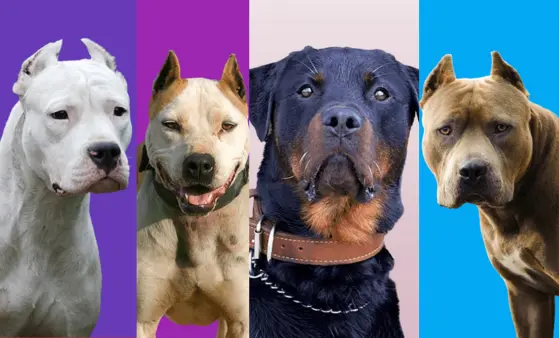Scariest Dog Breeds
Introduction
Dogs are often referred to as “man’s best friend,” but some breeds carry a reputation for being intimidating or even ” Scariest Dog Breeds” This perception is typically based on their physical appearance, size, or history as guard dogs or protectors. However, what is deemed “scary” in a dog breed often stems from misunderstandings or stereotypes rather than their true temperament.
In this article, we’ll explore the scariest dog breeds, examining the reasons behind their reputation and shedding light on their genuine nature. Whether you’re a dog lover or someone who has felt uneasy around certain breeds, understanding their characteristics can help demystify these powerful animals.
What Makes a Scariest Dog Breeds?
The label “Scariest Dog Breeds” is subjective and varies depending on individual experiences and cultural influences. However, certain traits commonly contribute to a breed being perceived as intimidating:
- Physical Appearance: Large size, muscular build, and prominent features like sharp teeth or cropped ears.
- History and Purpose: Breeds with a history of guarding, hunting, or working as police or military dogs.
- Media Influence: Movies, news stories, and myths often exaggerate the aggressiveness of specific breeds.
- Behavioural Misunderstandings: Misinterpreted actions, such as barking or protective instincts, can seem threatening.
It’s essential to remember that a dog’s behaviour is heavily influenced by training, environment, and individual personality.
The Scariest Dog Breeds and Their True Characteristics
1. Pit Bull Terrier

- Why They’re Perceived as Scary: Pit Bulls are often associated with aggression due to their history in dogfighting and their strong, muscular build.
- The Reality: When provided with proper training and early socialization, Pit Bulls are exceptionally loyal, affectionate, and make wonderful family companions. They are known for their playful and affectionate nature when raised in a positive environment.
2. Rottweiler

- Why They’re Perceived as Scary: Rottweilers are large, powerful dogs often used as guard or police dogs, which contributes to their intimidating image.
- The Reality: Rottweilers are intelligent and confident dogs. They are naturally protective but can be gentle, obedient, and affectionate with their families when trained and socialized properly.
3. Doberman Pinscher

- Why They’re Perceived as Scary: Their sleek, muscular build and cropped ears give them a sharp and commanding appearance.
- The Reality: Dobermans are incredibly intelligent, loyal, and often described as “Velcro dogs” for their attachment to their owners. They thrive both as beloved family companions and as reliable working dogs.
4. German Shepherd

- Why They’re Perceived as Scary: Frequently used as police and military dogs, German Shepherds are seen as fierce and unapproachable.
- The Reality: Renowned for their intelligence, trainability, and protective instincts, German Shepherds excel as loyal and dependable family pets. They are especially good with children when raised in a loving home.
5. Cane Corso

- Why They’re Perceived as Scary: This large, muscular breed with a commanding presence has historically been used as a guard dog.
- The Truth: Cane Corso’s are incredibly loyal and devoted to their families. While they have strong protective instincts, they can be calm, affectionate, and gentle when given proper socialization and training.
6. Bullmastiff

- Why They’re Perceived as Scary: Their massive size and muscular build make them appear imposing.
- The Reality: Despite their imposing size, Bullmastiffs are known for being gentle giants. They are calm, affectionate, and great with children, though they retain their natural guarding instincts.
7. Great Dane

- Why They’re Perceived as Scary: Known as the “Apollo of Dogs,” their towering height and deep bark can be intimidating.
- The Reality: Great Danes are gentle, affectionate, and often referred to as “gentle giants.” They are excellent companions and are usually friendly with strangers and other animals.
8. Alaskan Malamute

- Why They’re Perceived as Scary: Their wolf-like appearance and size can be intimidating to some.
- The Reality: Malamutes are social, playful, and affectionate. They thrive in active families and are known for their love of people.
9. Dogo Argentino

- Why They’re Perceived as Scary: Their strong, muscular build and reputation as hunting dogs contribute to their intimidating image.
- The Reality: The truth is, Dogo Argentinos are devoted, brave, and deeply loving companions to their families. They require experienced owners to ensure proper training and socialization.
10. Akita

- Why They’re Perceived as Scary: Their stoic demeanour, thick build, and reputation as protectors can seem intimidating.
- The Reality: Akita’s are deeply loyal and affectionate with their families. When given proper socialization, these dogs are known for their calm and gentle demeanour, despite their natural protective instincts.
Misconceptions and Media Influence
The media has played a significant role in labelling certain breeds as dangerous or Scariest Dog Breeds. Sensationalized stories about attacks often fail to consider the context, such as neglect, poor training, or abusive environments. This creates an unfair stigma around specific breeds.
Additionally, many so-called ” Scariest Dog Breeds” dogs are portrayed negatively in movies and television shows, further perpetuating stereotypes. For example, Dobermans and Rottweilers are often cast as villains’ pets, reinforcing their intimidating image.
The Role of Training and Socialization
The truth is, no dog is inherently dangerous or Scariest Dog Breeds. A dog’s behaviour is shaped by the environment in which it is raised, the training it receives, and the experiences it undergoes. Here are some tips for ensuring a well-behaved and friendly pet:
- Early Socialization: Expose your dog to various people, animals, and environments early on to reduce fear and aggression.
- Positive Reinforcement: Reward good behavior with treats and praise rather than punishing undesirable actions.
- Consistent Training: Establish clear rules and routines to build trust and understanding.
- Adequate Exercise: Ensure your dog gets enough physical and mental stimulation to prevent boredom and frustration.
Understanding Breed-Specific Needs
Each breed has unique characteristics and requirements. Owners must research their dog’s breed to provide the best care. For example, high-energy breeds like German Shepherds need plenty of exercise, while protective breeds like Akita’s require proper socialization to balance their instincts.
The Importance of Responsible Ownership
Owning a dog, especially a breed perceived as scary, comes with added responsibility. Responsible owners must:
- Understand the breed’s traits and needs.
- Train and socialize their dogs properly.
- Educate others about the breed’s true nature to combat stereotypes.
Conclusion
The term “scariest dog breeds” often reflects perception rather than reality. While some breeds have intimidating appearances or histories as protectors, they are not inherently dangerous or aggressive. With proper training, socialization, and care, these breeds can be loyal, loving, and gentle companions.
By understanding the true nature of these dogs, we can move beyond stereotypes and appreciate their unique qualities. After all, even the scariest-looking dog can have the biggest heart.



















This is very interesting, You’re a very skilled blogger.
I have joined your feed and look forward to seeking more of
your fantastic post.